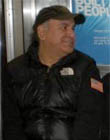|
|
This topic comprises 2 pages: 1 2
|
|
Author
|
Topic: Any prints of Nosferatu around?
|
|
|
|
|
Ian Price
Phenomenal Film Handler

Posts: 1714
From: Denver, CO
Registered: Jun 99
|
 posted 10-23-2002 03:48 PM
posted 10-23-2002 03:48 PM




The Alloy Orchestra has been touring with a print of Nosferatu this year. It was a brand new print of the 1920's film. We did it in Telluride a year ago.
here ALLOY ORCHESTRA
Contact: Ken Winokur
613 CAMBRIDGE STREET
CAMBRIDGE, MA 02141, USA
TEL: 617-497-6508, FAX: 617-876-5658 alloyorchestra@earthlink.net
| IP: Logged
|
|
|
|
|
|
|
|
|
|
|
|
|
|
Stephen Furley
Film God

Posts: 3059
From: Coulsdon, Croydon, England
Registered: May 2002
|
 posted 10-24-2002 04:46 AM
posted 10-24-2002 04:46 AM




It may well be easier to find a print of a film this age than one say ten years old.Filing out aperture plates to the required size is no problem. You will need a slightly longer lens than for Academy film, unless you can lift the top masking, to allow for the larger picture size. If you are using a separate anamorphic and backing lens for scope, then the backing lens on its own should be just right for silent. If you cannot do this, then you could probably borrow the lens(es) you need. If possible, you need to move the lens optical axis to the centre line of the film. Some projectors, mainly dual guage 35/70 ones, allow you to do this easily; if you can find a lens of smaller diameter than the projector is designed to take, then you can turn up a spacing bush, bored off-centre. If you can't do either of these, then you can either move the projector slightly, to centre the image on the screen, or move the masking out on the left side, if you can move left and right separately. Neither of these methods is ideal, the optical axis of the lens will not be correct, but, in practice, the difference is small enough not to make much difference. As a last resort, you can set your masking so that the left is correct, which means that you will have a rough edge on the right side of the picture. This really is a last resort, and is not recommended.  Whatever method you use, You may need to re-align the lamp to get even illumination across the whole frame area. Whatever method you use, You may need to re-align the lamp to get even illumination across the whole frame area. There is no such thing as silent speed, silent films could be intended to be shown at almost anything from 14 to 24 fps. Speeds tended to increase in later years. You really do need a variable speed; run the film at the speed that looks right on screen. On most projectors this is not too difficult to arrange. A Three bladed shutter is useful, but is easier to do on some projectors than others. If you cannot do this, and you are running at a slow speed, try reducing the light output slightly, flicker is more noticable on a bright image than on a slightly dimmer one. You may need to reduce the light anyway, to avoid damage to the print; the reduced running speed, and the silver content of black and white film can both cause overheating of the print. Make sure that there is nothing in the projector, or anything else the film passes through, sound heads, cleaners etc., which touches the film in the area between the normal frame, and the track area, and could cause scratches on a silent print. Depending on where the print comes from, you may not be allowed to cut leaders, to run it on a tower or platter, in this case, you will have to use two machines. Lastly, while it is most unlikely that an original print would turn up, when running a 35mm print of any old film, always make sure that it is not nitrate, unless you are fully equipped, and licenced, to run this. Don't be put off running silent film, all of the issues can be resolved, but plan it well in advance and get everything right, don't put on a bad show.
| IP: Logged
|
|
|
|
Leo Enticknap
Film God

Posts: 7474
From: Loma Linda, CA
Registered: Jul 2000
|
 posted 10-24-2002 07:16 AM
posted 10-24-2002 07:16 AM





Turn it round after cutting one edge, in order to avoid cutting past the frame edge and into the perforation area.Yes, vari-speed plus the right ratio plus a three-blade shutter are essential. The latter especially so, as Nosferatu should be shown at 16fps. With some two-blade shutters you can get away with speeds down to 18-19 with only a faint flicker, but for 16 forget it. If your 'scope prime lens detaches from the anamorph, it can be used for silent and the magnification will be very nearly right. The picture might bleed a bit at the top and bottom, but that's all. The British Film Institute has two Nosferatu 35mm prints - one 1970s black-and-white one which is in Academy with a canned soundtrack (but is not stretch-printed, so it will look as it should do when shown at 16). The original intertitles have been replaced with English translations and there is no tinting. BUT, the advantage of that would be that you wouldn't need to faff about with a full-gate lens and plate or offsetting the centre. The BFI also has a tinted and toned print of the Munich Filmmuseum restoration done by Martin Koerber in the early '90s, complete with original intertitles and artwork. However, the BFI will only let that print out to places they know and trust. They did also have a 16mm of the vandalised version but probably don't anymore (the BFI have all but stopped supporting 16mm). If you want to speak to the BFI about it, contact Kathleen Dickson or Fleur Buckley on 020 7255 1444.
| IP: Logged
|
|
|
|
|
|
Leo Enticknap
Film God

Posts: 7474
From: Loma Linda, CA
Registered: Jul 2000
|
 posted 10-24-2002 10:47 AM
posted 10-24-2002 10:47 AM





This can be a contentious issue. The bottom line is that the National Film and Television Archive's viewing service will respond to individual requests from cinemas based on (i) whether a title is available through normal, commercial channels, (ii) the ease with which copyright can be cleared, (iii) the intended use and (iv) technical specifications of the venue.I can't speak for the BFI, but my experience of them is that they wouldn't send one of their better prints to a venue they hadn't dealt with before unless they knew at least one of the key personnel (by 'knew', I mean knew that they were able to look after films properly based on his or her past record) there and thus that their print would be looked after. There is no formal 'approved list' (though some venues screen NFTVA prints as a matter of routine, e.g. the NFT, RFTs and certain festivals) and requests are considered on a case-by-case basis. The BFI does always insist that (i) their prints are shown in the correct ratio and, if applicable, sound format and (ii) the heads and tails of each reel are not removed, i.e. feature prints are only run using changeovers. I know that many on this forum will argue that film can be handled perfectly well on platters. The BFI's thinking on this is twofold. Firstly, archive prints are likely to be shown only once or twice at each venue, so the repeated building up and packing off relative to the number of passes is likely to inflict wear and tear more quickly. Secondly, mis-thread a single reel and you've only damaged 2,000 feet or so. Mis-thread a platter roll and there goes the whole print.
| IP: Logged
|
|
|
|
All times are Central (GMT -6:00)
|
This topic comprises 2 pages: 1 2
|
Powered by Infopop Corporation
UBB.classicTM
6.3.1.2
The Film-Tech Forums are designed for various members related to the cinema industry to express their opinions, viewpoints and testimonials on various products, services and events based upon speculation, personal knowledge and factual information through use, therefore all views represented here allow no liability upon the publishers of this web site and the owners of said views assume no liability for any ill will resulting from these postings. The posts made here are for educational as well as entertainment purposes and as such anyone viewing this portion of the website must accept these views as statements of the author of that opinion
and agrees to release the authors from any and all liability.
|

 Home
Home
 Products
Products
 Store
Store
 Forum
Forum
 Warehouse
Warehouse
 Contact Us
Contact Us




 Printer-friendly view of this topic
Printer-friendly view of this topic













 Whatever method you use, You may need to re-align the lamp to get even illumination across the whole frame area.
Whatever method you use, You may need to re-align the lamp to get even illumination across the whole frame area.




